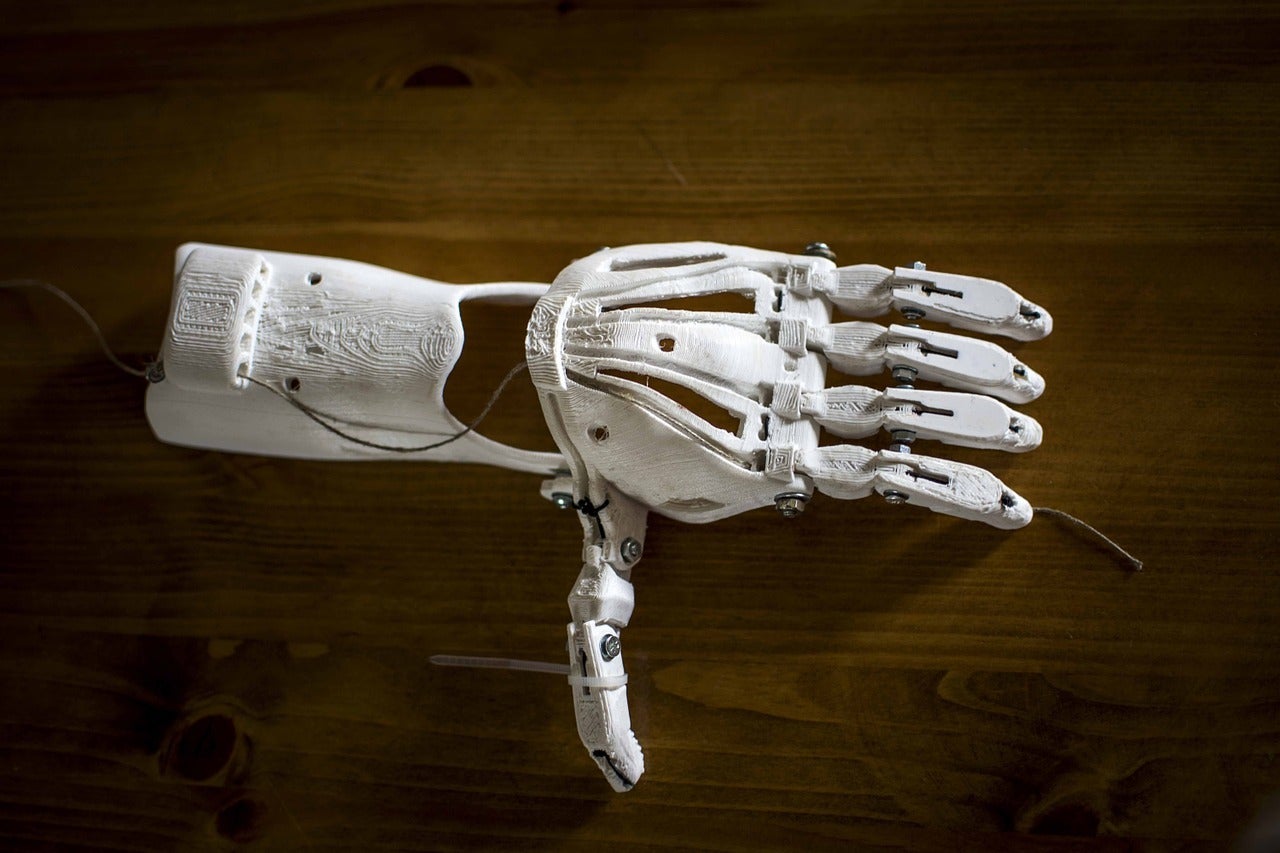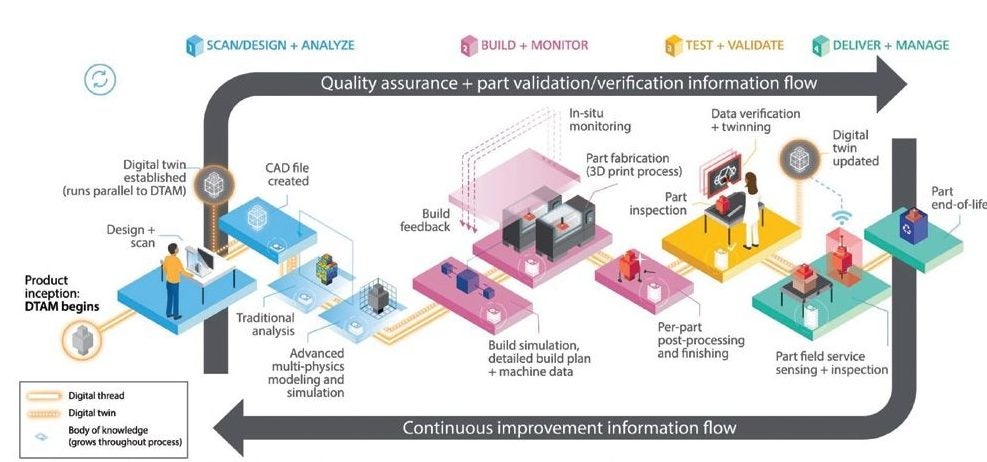
Additive manufacturing is attracting increased attention in the medical device sector, but analysts say more must be done to improve digital security. Patrick Kingsland asks Deloitte researchers how blockchain technology could help protect the 3D devices of tomorrow.
Printed skin made with living cells to conceal unsightly wounds. Replicas of hearts and other organs that help doctors plan for complicated surgeries. Computer-printed airway splints that let infants breathe just like their peers.
As 3D printing, or additive manufacturing, moves from obscurity into mainstream manufacturing facilities around the world, there seems to be few clinical areas the technology cannot be used for.
According to research by the Irish market research company Fact.MR, by the end of 2022, the global 3D-printing medical devices market will likely exceed more than $1.7 billion in revenue.
Every year, medical device companies are pumping out tens of millions of customised products, many with mass applications like hearing aids, dental crowns and bridges, as well as guides that help with common surgical operations.
“There is a great demand to customise devices to fit the needs of patients,” says Mark Cotteleer, executive director of Deloitte’s Center for Integrated Research. “Additive manufacturing could be a great solution not just because it might drive down cost but because it might actually improve clinical efficacy.”
But as the 3D printing revolution takes hold, a new set of challenges is also emerging. In December 2017, the FDA published a guidance document – Technical Considerations for Additive Manufactured Medical Devices – that raised a string of questions, and made a number of recommendations, about devices manufactured using additive processes.
“The unique aspects of the additive manufacturing process, such as the layer-wise fabrication process, and relative lack of experience and clinical history of devices manufactured using additive-manufacturing techniques, pose challenges in determining optimal characterisation and assessment methods for the final finished device, as well as optimal process validation and acceptance methods for these devices,” the document stated.
Security challenges
One of the chief concerns for regulators, patients and medical device companies is ensuring the security of 3D-printed products. Proper management of patient information is essential in any clinical application, but the issue is particularly critical for customised devices given the sheer amount of patient-specific data at hand.
A recent study by New York University’s Tandon School of Engineering – ‘Manufacturing and Security Challenges in 3D Printing’ – found that future 3D-printed devices may become the “focuses for attacks that could have a devastating impact on users of the end product, and economic impact in the form of recalls and lawsuits”.

Like any technology that exists in what analysts often call the “digitally distributed manufacturing environment”, the 3D-printing process must also be able to protect the intellectual property of the product, mitigate outside meddling and demonstrate data provenance – where data comes from and moves to, and who alters it over time.
“You are creating a digital model of what will become a medical device, whether that’s an implant or some other piece of mechanical equipment that has to be fabricated somewhere,” says Cotteleer. “The question becomes how you track these things through that product life cycle.”
It isn’t easy. While additive manufacturing might sound like a simple process involving a big printer and a person pushing an even bigger button, in reality, the process involves several intricate stages – from the initial design concept to the CAD file and the finished part. Each stage has its own particular vulnerability to theft and tampering.
And it’s a problem that is expected to get worse as the industry gains scale and the ‘digital thread’ that carries information through the additive-manufacturing process becomes distributed on a much wider, global stage.
The blockchain solution
It is in this context that some analysts have suggested blockchain as a possible solution to the security challenges presented by 3D printing. Though commonly associated with cryptocurrencies like bitcoin, experts say blockchain has a much wider application and could potentially serve as the security ‘backbone’ for additive manufacturing’s so-called ‘digital thread’.
Put simply, a blockchain system involves chains of information that get stored chronologically and across a network of computers. The chain is made available to anyone in a decentralised system, meaning altering a file becomes extremely difficult.
“It is about having that immutable, public-trusted record that says, ‘Where did this thing come from? Who has handled it? Where did it go? And what happened to it along the way?’ Because of these attributes, blockchain could likely have an application in this space,” says Cotteleer.

For a manufacturing process like 3D printing, which involves different stages and stakeholders, blockchain technology is ideal, adds Jonathan Holdowsky, a thought leader and co-author of Deloitte’s 2019 Global Blockchain Survey.
“Blockchain might be well suited for that kind of multiparty environment, especially when you have a long supply chain and more than one entity is generating transactions that modify the state of things,” he says.
Blockchain could also offer various design and organisational benefits. In an article published on LinkedIn, the digital strategist and blockchain proponent Josué Batista praised the technology’s ability to help manage data within and among different stakeholders. “That is important for additive manufacturing because it helps in the management of activities in distributed supply chains,” Batista said.
With blockchain technologies getting faster, Batista added that instantaneous settlement and exchange will enable manufacturers to make quick changes to product design, creating an all-round more efficient process.
Emerging market
While the market for products that can integrate blockchain and additive manufacturing is yet to properly take off, a number of companies are now entering the space.
“There are quite a few significant players in the software industry that are looking at, or invested in, blockchain applications,” says Cotteleer, adding that, “The pace of change and development is always accelerating though seldom predictable.”
Last year, a Manhattan-based additive-manufacturing software company said it had debuted the “first-ever integration of blockchain technology” for the 3D-printing industry.
Based on the premise that the ‘digital thread’ is crucial for mass adoption of additive manufacturing, the company says it has created a solution that can ensure tracking of design files and products as they pass through the supply chain.
An Indian IT consultancy, Wipro, has also developed a blockchain technology for additive manufacturing with the goal of preventing IP theft and making the general production processes nimbler.
Among the information captured by Wipro’s blockchain solution is the raw material used in the 3D device – production parameters, technical specifications, where the product was manufactured, and how it was stored and maintained.
“Something is happening in the marketplace,” says Holdowsky. “There is a kind of second-order effect kicking in where you know organisations that might have looked askance at blockchain technology in the past are now taking it seriously.”

The pertinent question of transparency
Of course, few believe that blockchain is a silver bullet, and the system is likely to encounter the same questions it does in other applications. Some may, for example, view the concept of transparency – where data is exchanged between multiple parties – as a business risk, while others may question where legal responsibility really lies when an algorithm is essentially in control.
“People need to understand all the trade-offs with blockchain,” says Cotteleer. “Who is in the supply chain? Do they trust them? What are the costs and benefits? All those issues are standard blockchain in supply chain questions.”
As things stand, blockchain solutions are gaining traction across the medical space. A recent global survey by Deloitte found that the majority of healthcare respondents, 63%, are planning to invest over $1 million into blockchain.
Three-quarters of healthcare executives and 70% of life sciences executives surveyed in the same study described their understanding of blockchain as either “excellent” or “expert”.
For the authors of the Deloitte report ‘3D opportunity for blockchain’, all decisions on using blockchain solutions should be made on a case-by-case basis, but the technology nonetheless provides “an intriguing path for the additive-manufacturing industry to explore further”.
The authors add, “Companies and organisations should keep a finger on the pulse of developments in the blockchain space as they look to build secure and connected manufacturing infrastructure. With the ever-increasing need for connectedness and security, blockchain may provide the backbone enabling manufacturing of the future.”
This article originally appeared in the 2019 Vol 2 edition of Medical Device Developments. The full issue can be viewed here.






